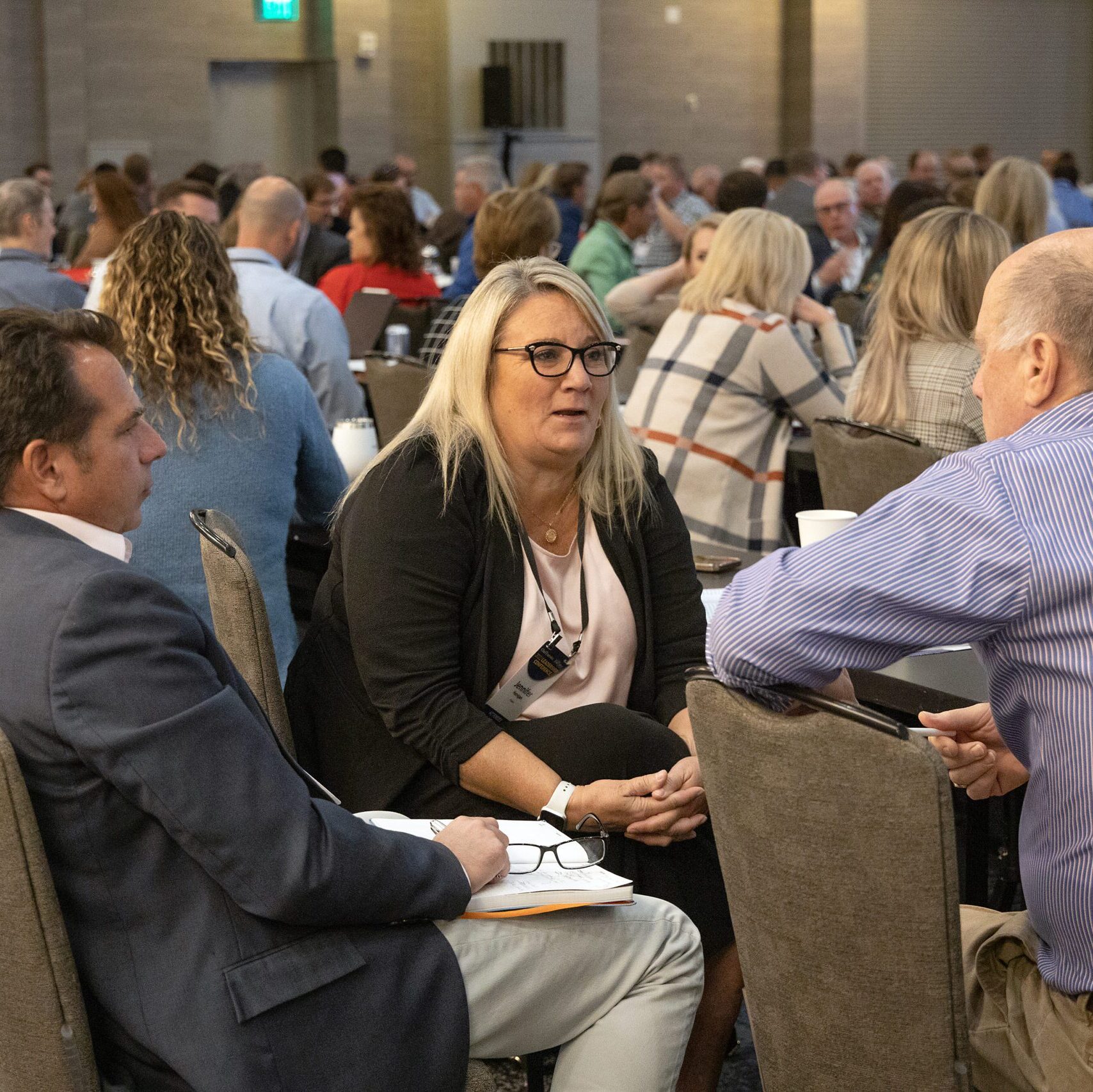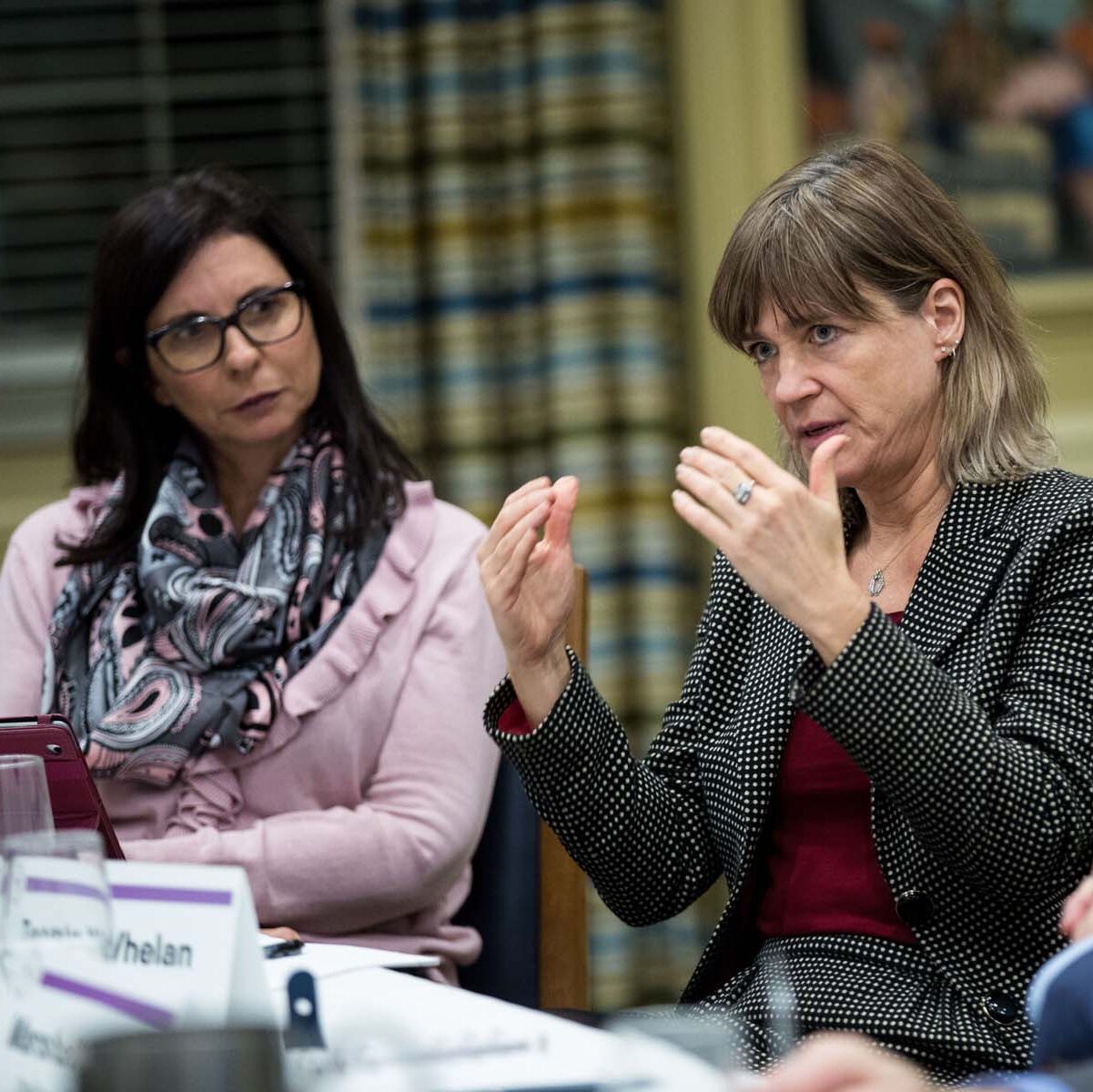
United States and an increasingly global marketplace are driving recognition that diversity is more than simply the right thing to do. Diversity programs represent a way for companies to fuel growth by tapping into fast-growing multicultural markets.
By 2005, the U.S. Census Bureau projects one in three Americans will be either African American, Hispanic American or Asian Pacific American. Together, these three groups are increasing seven times faster than the population as a whole. This shifting population mix, along with the demands of growing international markets, have CEOs across industries wrestling with diversity as never before.
 “For us, diversity is really a marketplace necessity,” Thomas O’Neill, chief executive of New York City-based Parsons Brinckerhoff, told CEOs gathered for a recent roundtable discussion on diversity best practices held in partnership with Pitney Bowes. “Whenever you make a sales pitch to a government agency, you interview with a panel that includes women and people of color. So if we go in there with all Caucasian males, our chances to win a job go way down, whereas if we go in with a group who look like the people on the other side of the table, our chances go up. That’s just a marketplace reality.”
“For us, diversity is really a marketplace necessity,” Thomas O’Neill, chief executive of New York City-based Parsons Brinckerhoff, told CEOs gathered for a recent roundtable discussion on diversity best practices held in partnership with Pitney Bowes. “Whenever you make a sales pitch to a government agency, you interview with a panel that includes women and people of color. So if we go in there with all Caucasian males, our chances to win a job go way down, whereas if we go in with a group who look like the people on the other side of the table, our chances go up. That’s just a marketplace reality.”
Clearly, a company’s work force-including senior management-must represent all of its customers to win their loyalty. And yet, despite the business case for diversity and increasing emphasis on multicultural initiatives, true diversity continues to elude many corporations. Resistance to change and misconceptions are among the factors impeding the process, reported Phillip Cox, chairman of Cincinnati Bell. “This is very threatening and difficult for our employee base, of which out of 3,000 people we have about 700 people of color,” he said. “These are not racist people, but we are all prisoners of the familiar. And that means we don’t get up in the morning and say, ��I think I’ll go out and make myself as uncomfortable as I can by dealing with someone who is very different from me.'”
Even CEOs at companies with diverse work forces and long-established diversity initiatives continue to struggle to extend multiculturalism to the upper echelons. At North Shore-Long Island Jewish Health System, where 7,800 of 8,000 nurses are women, the executive ranks are another story. “When you go down into most large organizations, you have a very diverse work force,” noted Michael Dowling, CEO of the Great Neck, N.Y.-based hospital company. “The problem is getting diversity in terms of race and gender up to the very top of the organization.”
 It’s also knowing how to get the most value from the diversity created, said Michael Critelli, chairman and CEO of Pitney Bowes. “When we talk about diversity, it isn’t just about equal opportunity, it isn’t just about bringing in the best talent in a broad diverse marketplace, but it’s what you do when you get there. Do you get the full benefit of people’s diverse life experiences? And do you get the creative tension associated with that?”
It’s also knowing how to get the most value from the diversity created, said Michael Critelli, chairman and CEO of Pitney Bowes. “When we talk about diversity, it isn’t just about equal opportunity, it isn’t just about bringing in the best talent in a broad diverse marketplace, but it’s what you do when you get there. Do you get the full benefit of people’s diverse life experiences? And do you get the creative tension associated with that?”
What’s more, for today’s CEOs these challenges come on the heels of a difficult economic period. Metal Management, which survived a bankruptcy reorganization in 1999, is in the early phase of its efforts to promote diversity through internal promotions and external recruitment. “First we had to fix the organization. Now we’re focused on the culture,” explained Michael Tryon, president and COO of the Chicago company, where a significant African-American and Latin-American presence among the company’s labor force is not reflected in upper management. “We need to go out and get more thinking-outside-of-the-box talent within the company. We don’t have enough women and minorities at the supervisor, managerial and executive levels. Culturally, we’re going to have to turbocharge where we are today.”
Diversity is an even more intense challenge for non-U.S. companies, said Robert Westerhof, CEO of North American operations for Philips Electronics, which began setting standards for the number of women in top jobs a few years ago. “Diversity is one of the things that we’re not good at in Europe, because with our history of knowing so many things about other parts of the world, we thought it was not needed,” he said. “So American-based companies put more effort into diversity than European-based companies.”
Paths to Progress
While the mission is clear-to foster an inclusive culture that strengthens relationships with employees, suppliers, customers and communities-methods of achieving that elusive goal continue to spark debate. For example, although many companies report success with diversity programs within HR that encompass employee affinity networks, mentoring programs and diversity training, several CEOs argued that bringing diversity out of HR as a standalone function is an essential step in building momentum.
Dan Carp, CEO of Eastman Kodak in Rochester, N.Y., credited establishing a separate global diversity function for communicating the company’s commitment to diversity and assessing progress. “Putting it in HR doesn’t give it enough visibility and importance in the company,” he reported. “So we have a diversity office that works closely with, but is not part of, HR. Our chief diversity officer sits down with all of our key operating managers to go through their diversity plans for the year and give them her perspective of how they did during the previous year. This is a face-to-face conversation, and they know that feedback will come to me and bonuses will be based on that. It’s not tangled up in HR.”
Similarly, Dowling created the position of chief learning officer, charged with overseeing diversity as well as the broader challenge of promoting continuous learning within the company. “HR tends to be a [support function] rather than a strategic partner in the organization,” he explained. “The goal here is to make this not a project, but an integral part of the way we operate on a day-to-day basis, part of the ongoing organizational DNA of the place. So you’ve got to get HR to continually promote not only employee development but diversity. I did that by putting HR under the chief learning officer.”
But even as CEOs of large firms establish and widely promote separate and formal diversity programs, some of their peers advocate a more informal approach. “You don’t need an official program to create diversity,” contended John Shalam, chairman and CEO of Hauppauge, N.Y.-based Audiovox, who said multiculturalism is baked into his company culture due, in part, to its origins. “I immigrated to this country from Egypt and the president of my largest subsidiary was born and raised in Cyprus. We strongly believe in opportunity, and our influence on the company has been pronounced.” As a result of extensive dealings in Asia, he added, the company also employs Japanese, Korean and Chinese staff members.
At Audiovox, said Shalam, diversity happens naturally, fostered in part by employee development programs. “We have a lot of production workers who are of Spanish descent and we do things like run classes in English as a second language, print materials bilingually and try to get them more involved in the company,” he said. “We promote diversity more on an evolutionary basis than through a formal effort.”
Similarly, Sunil Kumar, CEO of International Specialty Products in Wayne, N.J., takes a “live it and do it” approach to gender diversity. “If we were a much larger company, I’m sure we would need a formal program,” he noted. “But as a small, private company we just tell all of our managers that one, we expect superior returns, and two, we expect everybody to be truly color blind. And overall, our ethnic and gender representation is very good.”
While Danbury, Conn.-based Ethan Allen also lacks a formal diversity effort, gender diversity in upper management has been a natural outcropping of a companywide leadership development effort. “Fifteen years back, we had no women in senior or even middle management. Today, 70 percent of our senior and middle managers are women,” said CEO Farooq Kathwari. “If you start with the principle that justice and equality are important, then you treat people fairly and whoever is the right person gets the job. But you also have to create an environment where you help people grow.”
But for many companies, formal diversity programs that encompass performance incentives and other goal and measurement mechanisms are key elements of building a culture that embraces diversity. “The No. 1 device is making it a core part of people’s performance objectives,” asserted Critelli, of Pitney Bowes, which uses a balanced scorecard process to evaluate business units and staff functions on achieving diversity goals. “We have core objectives every single year that our board holds us accountable for; roughly 15 percent of our incentive compensation is based on leadership, talent development and diversity. It all starts with the basic principle that what gets measured, gets done.”
Taking It From the Top
Pitney Bowes extends that diversity protocol to its senior team and managers, where 30 to 35 percent of the top 25 executives are women and 12 to 15 percent are minorities. The company sees diversity among its leadership team and corporate board, which includes women and people of color, presenting a crucial role model for the organization to follow.
 At Cushman and Wakefield, diversity efforts languished until the company’s CEO got personally involved. In fact, sheer frustration spurred progress, recounted CEO Arthur Mirante, who described adding diversity to the real estate company’s value statement only to have nothing happen. “I became really frustrated and launched into action,” he said. The effort began with mandates that he personally delivered to his direct reports. “In New York City, for example, our problem was not having African Americans on our management team, so I said, ��Within the next 18 months your No. 2 report will be an African American.'”
At Cushman and Wakefield, diversity efforts languished until the company’s CEO got personally involved. In fact, sheer frustration spurred progress, recounted CEO Arthur Mirante, who described adding diversity to the real estate company’s value statement only to have nothing happen. “I became really frustrated and launched into action,” he said. The effort began with mandates that he personally delivered to his direct reports. “In New York City, for example, our problem was not having African Americans on our management team, so I said, ��Within the next 18 months your No. 2 report will be an African American.'”
HR questioned these directives, but Mirante was unfazed. “I was told it was illegal and other things I couldn’t believe, which just resonated to me that I really need to be forceful,” he said. “We’ve made dramatic changes the last three, four years, which feels good-and, frankly, we’re also winning more business because of it. But we still have a way to go.”
For Deloitte Touche Tohmatsu, the view that multiculturalism offers a strategic advantage also led the way for diversity among the company’s executive and management teams and its board of directors, reported William Parrett, global chief executive of the accounting firm. Further evidence of the company’s commitment is a decision-making process that gives one vote to each of the company’s global operations, regardless of their relative size. “The U.S., for example, represents 35 percent of our revenue, but does not have 35 percent of the vote,” he explained. “The purpose of that is to build a multicultural organization over the long term.”
Like many large companies, Deloitte also requires minority and gender representation on teams and insists that a diverse slate of candidates be considered for top spots. “Unless you influence the leadership appointment process, we find that white males will, generally speaking, pick a white male, or a U.S. partner looking for an appointment in the U.S. will generally pick another U.S. partner,” Parrett says. “Every time we create a team, we step back and evaluate that team based on its diversity. It could be diversity from color, from sex, from background, but it’s rare that we form a team that is not diverse.”
Harold Yoh, CEO of Day & Zimmermann Group, described a similar recruitment initiative practiced by his global diversified managed services company. “From a hiring perspective, we tell our people you have to interview at least one diverse candidate for every outside job,” he said. “We’re not saying we want to have quotas, but we do want our people to go out and to find diverse talent. We believe that if we have a more diverse team, we’ll have richer solutions for our clients.”
That’s proved the case for The MONY Group, where recruiting diverse employees led to changes in both the company’s marketing efforts and product offerings. “The Hispanic market is the largest-growing market for our products in the United States, yet none of the people we were having distribute our products in those markets were Hispanic,” recounts Michael Roth, CEO of the New York insurance firm, who launched a diversity recruiting effort. “Once we started hiring and recruiting people from those ethnic markets, we found that our products did not relate to these people at all. So we had them put together projects to change our products and market efforts so that we can actually access the markets.”
While initiatives with respect to recruitment and promotion of minorities are a common element of many formal diversity programs, Cox urged caution in adopting measures that might be perceived as quotas and could spark employee backlash. “I am bothered when someone says we lost a woman, we have to make sure we find another woman to maintain our gender diversity,” he said. “When you say diversity to some people that means favoritism; it means everything but what we intend it to mean. So we don’t use the word diversity.”
Instead, to win employee support across the company, he urges emphasizing the business case for diversity. “We talk about the development of people to try to get them to full capacity, and then we can talk about who some of those people may be,” he explained. “This is an issue that we solve by showing people that this will improve all of us, make us a stronger company-not by directing it at any group as if we’re trying to push that group up the ladder.”
But companies further along the diversity learning curve find that open communication on diversity efforts can foster broad-based employee buy-in. “There’s nothing wrong with intervening to create an upward draft for groups that are underrepresented, and we’re not embarrassed about doing it,” said Eastman Kodak’s Carp. “We have no problem standing up in front of the organization and saying, ��Look, we’ve got overrepresentation of white males in leadership and supervisor roles. If we’re going to be a diverse company, we’re going to have to intervene and create upward draft because we won’t get there without diversity.'”
At Pitney Bowes, senior managers discuss diversity issues and answer employee questions at quarterly Town Hall-style meetings. “One of the things that makes diversity work is to give everyone the opportunity to question and to make suggestions and comments to senior management in an open forum,” Critelli noted.
Ultimately, efforts to educate about the benefits can help diversity evolve from programs and initiatives to become an intrinsic part of a company’s corporate culture, added Carp. “Diversity is a journey,” he pointed out. “If you put in place a process with goals and objectives and then elements to broadly energize people around the diversity issue, you start to change people’s minds because they see the business value of it.”
Diversity at Kodak CEO Dan Carp is “dead serious” about it.
How do you move beyond mechanisms to actually creating an inclusive culture? Second, the stick. I am personally dead serious about diversity. I believe it is a key element of the success of our company, and I have managers around me who also carry that commitment. We have a global diversity leadership team of senior executives who meet regularly to talk about where to push the strategy of the company on diversity. We have no-tolerance policies around discrimination and harassment that we follow through on. How do you measure the return on diversity efforts? But trying to build a commitment to diversity solely on quantifiable dollars and cents diminishes the importance of the endeavor. We tend to want to quantify the cost savings or [increased revenues], but the higher level piece is a top line benefit. This country was built on diverse groups coming together. We are one of the most diverse populations in the world-and we happen to also be one of the most creative in terms of an economy that keeps reinventing itself. If you step back and say a company’s job is to constantly reinvent itself and bring new products and services that add value, you have to reach the conclusion that you can drive a better top line by making sure all people and all ideas are valued.
|

Chief Executive Group exists to improve the performance of U.S. CEOs, senior executives and public-company directors, helping you grow your companies, build your communities and strengthen society. Learn more at chiefexecutivegroup.com.
0

1:00 - 5:00 pm
Over 70% of Executives Surveyed Agree: Many Strategic Planning Efforts Lack Systematic Approach Tips for Enhancing Your Strategic Planning Process
Executives expressed frustration with their current strategic planning process. Issues include:
Steve Rutan and Denise Harrison have put together an afternoon workshop that will provide the tools you need to address these concerns. They have worked with hundreds of executives to develop a systematic approach that will enable your team to make better decisions during strategic planning. Steve and Denise will walk you through exercises for prioritizing your lists and steps that will reset and reinvigorate your process. This will be a hands-on workshop that will enable you to think about your business as you use the tools that are being presented. If you are ready for a Strategic Planning tune-up, select this workshop in your registration form. The additional fee of $695 will be added to your total.

2:00 - 5:00 pm
Female leaders face the same issues all leaders do, but they often face additional challenges too. In this peer session, we will facilitate a discussion of best practices and how to overcome common barriers to help women leaders be more effective within and outside their organizations.
Limited space available.

10:30 - 5:00 pm
General’s Retreat at Hermitage Golf Course
Sponsored by UBS
General’s Retreat, built in 1986 with architect Gary Roger Baird, has been voted the “Best Golf Course in Nashville” and is a “must play” when visiting the Nashville, Tennessee area. With the beautiful setting along the Cumberland River, golfers of all capabilities will thoroughly enjoy the golf, scenery and hospitality.
The golf outing fee includes transportation to and from the hotel, greens/cart fees, use of practice facilities, and boxed lunch. The bus will leave the hotel at 10:30 am for a noon shotgun start and return to the hotel after the cocktail reception following the completion of the round.